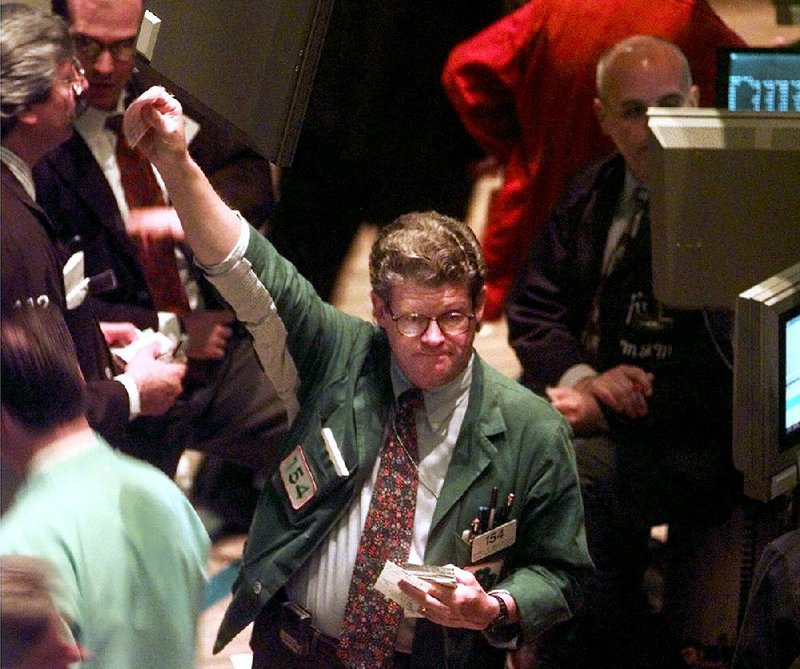NEW YORK -- The furious rally that's brought the S&P 500 to the brink of another record, so quickly on the heels of last year's scary tumble, is reminding some market veterans of the rebound of late 1998. Then, like now, decisions by the Federal Reserve on interest rates helped send stocks soaring. Then, like now, high-flying technology stocks were leading the way. And, in both instances, investors wondered how much longer the economy could avoid a recession after years of growth.
Few, if any, analysts on Wall Street are predicting a repeat of 1999 and 2000, when the market's recovery ended up becoming too much of a good thing. The S&P 500 surged nearly 60 percent from its 1998 bottom and inflated into the dot-com bubble, only to burst in the dot-com bust. The collapse dashed the dreams of day traders around the country and helped usher in the 2001 recession.
But the similarities between 1998-1999 and 20 years later are plentiful enough that some investors are pushing the idea that stocks can keep rising even with recession fears still hanging over the market.
Stocks finished a wobbly day of trading Wednesday on Wall Street with modest losses that erased most of the market's slight gains from a day earlier.
The S&P 500 fell 6.61 points, or 0.2 percent, to 2,900.45. The Dow Jones industrial average dropped 3.12 points, or less than 0.1 percent, to 26,449.54.
The Nasdaq composite slid 4.15 points, or less than 0.1 percent, to 7,996.08. The Russell 2000 index of small-cap stocks gave up 15.19 points, or 1 percent, to 1,567.60.
European stock indexes finished higher. Decliners outnumbered gainers on the New York Stock Exchange.
A sharp sell-off in health-care companies far outweighed gains in technology and other sectors. Smaller company stocks fell more than the rest of the market.
Investors are poring over company earning reports this week, focusing on companies' profit and revenue outlooks for the rest of this year. Analysts expect the first quarter results for S&P 500 companies overall to be the weakest in nearly three years.
"The market is in wait-and-see mode," said Jamie Lavin, global investment specialist at JP Morgan Private Bank. "We're only 10 percent through earnings season, but so far, so good."
Steve Chiavarone, equity strategist at Federated Investors, says the S&P 500 may end the year at 3,100. That would be a 6.6 percent rise from Tuesday's close and a nearly 32 percent leap from Christmas Eve, when recession fears were at their height.
"It is unfathomable to someone at this stage, as it was in 1998, that you could have meaningful upside in the market given where we are," Chiavarone said. "I think you have to be respectful that tops are impossible to call and that things can get ahead of themselves."
In the summer of 1998, the S&P 500 was at a record high, and the U.S. economy was more than seven years into its expansion, one of the longest on record. But turmoil in developing economies around the world, highlighted by the Asian financial crisis and then Russia's default on its debt, helped send the S&P 500 down nearly 20 percent.
The Fed calmed worries that the turbulence abroad would dash the U.S. economy by slashing interest rates three times in three months in late 1998. The S&P 500 recovered within a few months.
The action then is reminiscent of the market's movements over the past seven months. Last winter, after setting its all-time high on Sept. 20, the S&P 500 plunged 19.8 percent on worries that a recession was on the way. But the Fed again helped put a floor under the stock market, this time by saying it may not raise rates at all this year after seven increases the previous two years.
The S&P 500 has shot up 23.6 percent since hitting a bottom on Christmas Eve, echoing the 24.1 percent climb for the index in the same number of trading days after it hit a bottom in August 1998.
High-growth stocks are also leading the way, once again. In the late '90s, investors flocked to technology stocks because they were going to drive the "new economy." Today, companies like Facebook, Microsoft and Netflix are alluring because they're producing strong growth even when global economic growth is slowing and low interest rates make conservative investments more unattractive.
The market has prodded a parade of tech companies to sell their stock to regular investors for the first time. Lyft had its last month, and Uber and other big names should follow shortly.
These companies are generally more seasoned than their initial public offering counterparts two decades ago, with more in revenue. But most lose money, and the last time such a high percentage of companies going public were unprofitable was in 2000, when the dot-com bubble was at its height.
All this is happening while the bond market has sent signals of caution through what's known as the yield curve. Recently, some key short-term Treasury yields were higher than for some longer-term Treasuries, which is unusual. Market watchers call the phenomenon an "inverted yield curve," and such a scenario has preceded past recessions, although it hasn't been a perfect predictor. In 1998, some parts of the yield curve were also inverted.
"The froth is really starting to pick up now," said Doug Ramsey, chief investment officer at Leuthold Group. "I would never argue that this is like the euphoria you saw in the late 90s -- we're nothing close to that -- but you're still positioned just as precariously in chasing these large-cap growth stocks."
Information for this article was contributed by Alex Veiga of The Associated Press.
Business on 04/18/2019
